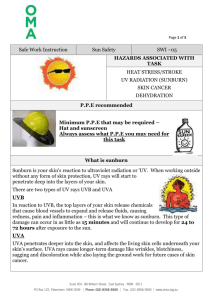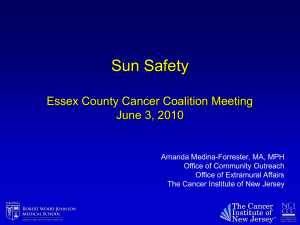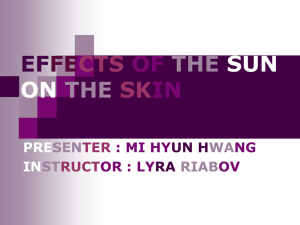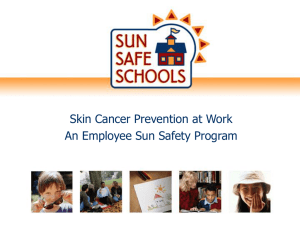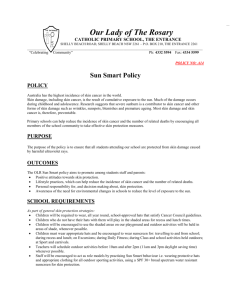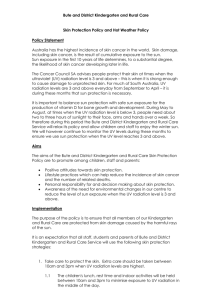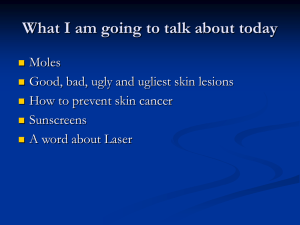FACTS ABOUT SUNSCREENS - American Academy of Dermatology
advertisement
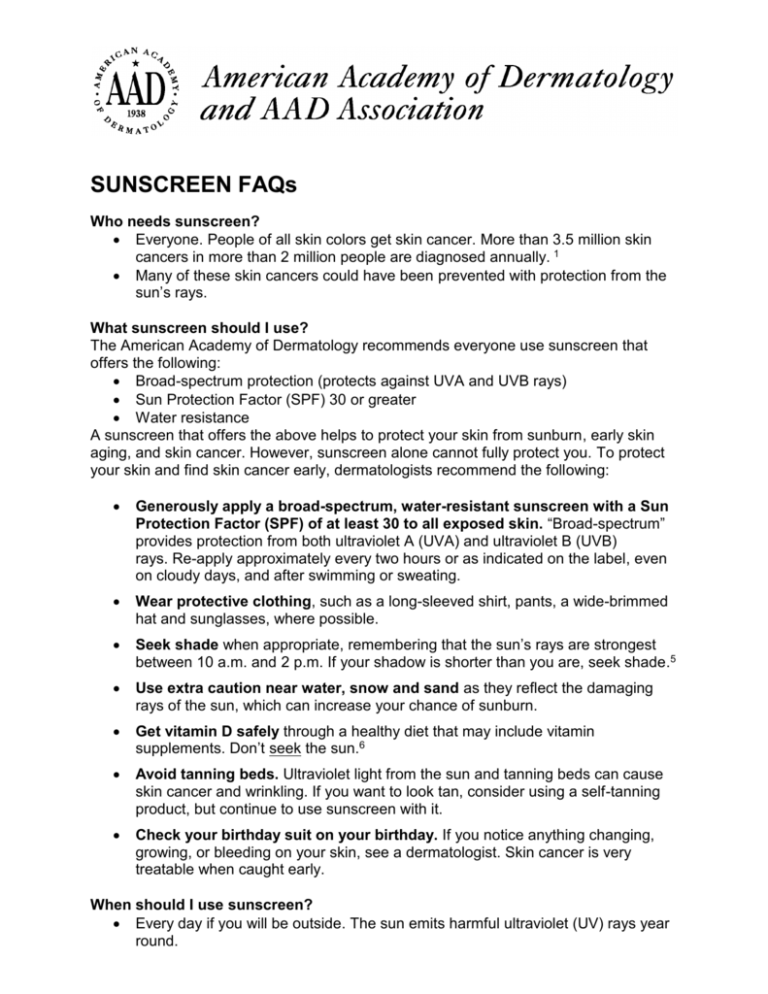
SUNSCREEN FAQs Who needs sunscreen? Everyone. People of all skin colors get skin cancer. More than 3.5 million skin cancers in more than 2 million people are diagnosed annually. 1 Many of these skin cancers could have been prevented with protection from the sun’s rays. What sunscreen should I use? The American Academy of Dermatology recommends everyone use sunscreen that offers the following: Broad-spectrum protection (protects against UVA and UVB rays) Sun Protection Factor (SPF) 30 or greater Water resistance A sunscreen that offers the above helps to protect your skin from sunburn, early skin aging, and skin cancer. However, sunscreen alone cannot fully protect you. To protect your skin and find skin cancer early, dermatologists recommend the following: Generously apply a broad-spectrum, water-resistant sunscreen with a Sun Protection Factor (SPF) of at least 30 to all exposed skin. “Broad-spectrum” provides protection from both ultraviolet A (UVA) and ultraviolet B (UVB) rays. Re-apply approximately every two hours or as indicated on the label, even on cloudy days, and after swimming or sweating. Wear protective clothing, such as a long-sleeved shirt, pants, a wide-brimmed hat and sunglasses, where possible. Seek shade when appropriate, remembering that the sun’s rays are strongest between 10 a.m. and 2 p.m. If your shadow is shorter than you are, seek shade.5 Use extra caution near water, snow and sand as they reflect the damaging rays of the sun, which can increase your chance of sunburn. Get vitamin D safely through a healthy diet that may include vitamin supplements. Don’t seek the sun.6 Avoid tanning beds. Ultraviolet light from the sun and tanning beds can cause skin cancer and wrinkling. If you want to look tan, consider using a self-tanning product, but continue to use sunscreen with it. Check your birthday suit on your birthday. If you notice anything changing, growing, or bleeding on your skin, see a dermatologist. Skin cancer is very treatable when caught early. When should I use sunscreen? Every day if you will be outside. The sun emits harmful ultraviolet (UV) rays year round. Facts About Sunscreens Page 2 Even on cloudy days, up to 80% of the sun’s harmful UV rays can penetrate your skin. Snow and sand increase the need for sunscreen because they reflect the sun’s rays.2 How much sunscreen should I use, and how often should I apply it? Use enough sunscreen to generously coat all skin that will be not be covered by clothing. Ask yourself, “Will my face, ears, arms, or hands be covered by clothing?” If not, apply sunscreen. Most people only apply 25-50% of the recommended amount of sunscreen.3 Follow the guideline of “one ounce, enough to fill a shot glass”, which dermatologists consider the amount needed to cover the exposed areas of the body. Adjust the amount of sunscreen applied depending on your body size. Apply the sunscreen to dry skin 15 minutes BEFORE going outdoors. Skin cancer also can form on the lips. To protect your lips, apply a lip balm or lipstick that contains sunscreen with an SPF of 30 or higher. Re-apply sunscreen approximately every two hours or after swimming or sweating heavily according to the directions on the bottle. Broad-spectrum sunscreens protect against both UVA and UVB rays. What is the difference between the rays? Sunlight consists of two types of harmful rays that reach the earth – ultraviolet A (UVA) rays and ultraviolet B (UVB) rays. Overexposure to either can lead to skin cancer. In addition to causing skin cancer, here’s what each of these rays do: UVA rays can prematurely age your skin, causing wrinkles and age spots, and can pass through window glass. UVB rays are the primary cause of sunburn and are blocked by window glass. The United States Department of Health & Human Services and the World Health Organization’s International Agency of Research on Cancer have declared ultraviolet (UV) radiation from the sun and artificial sources, such as tanning beds and sun lamps, as a known carcinogen (cancer-causing substance). 4 There is no safe way to tan. Every time you tan, you damage your skin. As this damage builds, you speed up the aging of your skin and increase your risk for all types of skin cancer. Who regulates sunscreens? Sunscreen products are regulated as over-the-counter (OTC) drugs by the U.S. Food and Drug Administration (FDA). The FDA has several safety and effectiveness regulations in place that govern the manufacture and marketing of all sunscreen products, including safety data on its ingredients How do the FDA sunscreen guidelines affect my sunscreen? As of December 2012, sunscreen labels will provide you with more information about what type of UV protection a sunscreen offers, and what a sunscreen can do. On the label, you’ll see whether the sunscreen: Facts About Sunscreens Page 3 Is Broad Spectrum and has an SPF 15 or higher, which means the sunscreen protects against UVB and UVA rays. Has a Skin Cancer/Skin Aging Alert in the Drug Facts section of the label, which means the sunscreen will only prevent sunburn and not reduce the risk of skin cancer and early skin aging Is Water Resistant up to 40 minutes or 80 minutes which means the sunscreen provides protection while swimming or sweating up to the time listed on the label Are sunscreens safe? Using sunscreen, seeking shade and wearing protective clothing are all important behaviors to reduce your risk of skin cancer. Scientific evidence supports the benefits of using sunscreen to minimize short-term and long-term damage to the skin from the sun’s rays. Preventing skin cancer and sunburn outweigh any unproven claims of toxicity or human health hazard from ingredients in sunscreens. What type of sunscreen should I use? The best type of sunscreen is the one you will use again and again. Just make sure it offers broad-spectrum (UVA and UVB) protection, an SPF of 30 or greater, and is water resistant. The kind of sunscreen you choose is a matter of personal choice, and may vary depending on the area of the body to be protected. Available sunscreen options include lotions, creams, gels, ointments, wax sticks and sprays. Creams are best for dry skin and the face. Gels are good for hairy areas, such as the scalp or male chest. Sticks are good to use around the eyes. Sprays are sometimes preferred by parents since they are easy to apply to children. Make sure to use enough of these products to cover the entire surface area thoroughly. Do not inhale these products or apply near heat, open flame or while smoking. There also are sunscreens made for specific purposes, such as for sensitive skin and babies. Regardless of which sunscreen you choose, be sure to apply it generously to achieve the UV protection indicated on the product label. Is a high-numbered SPF better than a lower-numbered one? Dermatologists recommend using a sunscreen with an SPF of at least 30 which blocks 97% of the sun’s rays. Higher number SPFs block slightly more of the sun’s rays but no sunscreen can block 100% of the sun’s rays. High-number SPFs last the same amount of time as low-number SPFs and should be applied approximately every two hours or according to time on the label, even on cloudy days, and after swimming or sweating. Are spray sunscreens safe to apply? What if you inhale the fumes? The FDA is currently investigating the toxicity risks of spray sunscreens and the fumes they produce. The challenge in using spray sunscreens is that it is difficult to know if Facts About Sunscreens Page 4 you have used enough spray sunscreen to cover all parts of your body exposed to the sun’s rays. If you miss an area of your body or do not use enough sunscreen on a part of your body your risk of skin cancer, sunburn, and early skin aging will increase. To avoid the fumes, never spray sunscreen around or near the face or mouth. Spraying adequate amounts of the sunscreen into your hands and then applying the sunscreen can help avoid the fumes while also ensuring adequate coverage. What type of sun protection should I follow for my baby? Ideally babies under 6 months should avoid spending time exposed to the sun’s rays. The best sun protection for babies is to keep them in the shade as much as possible in addition to wearing long sleeves, pants, a wide-brimmed hat, and sunglasses. Make sure they do not get overheated and that they drink plenty of fluids. If your baby is fussy, crying excessively, or has redness on any exposed skin they should be moved indoors. Babies have much more sensitive skin than adults and sunscreen should be avoided. Can I apply sunscreen on a toddler or infant? Sunscreen can be applied to toddlers and infants 6 months or older and should only be applied to exposed skin not covered by long sleeves, pants, wide-brimmed hats, and sunglasses. Sensitive areas (ears, neck, cheeks) or areas that are not covered by clothing should have a broad-spectrum, water-resistant sunscreen of at least SPF 30 applied according to the product label. The sunscreen should be reapplied approximately every two hours or as often as the label says. Sunscreens that use the ingredients zinc oxide or titanium dioxide or special sunscreens made for infants or toddlers may cause less irritation to the sensitive skin of infants and toddlers. Can I use the sunscreen I bought last summer, or do I need to purchase a new bottle each year? Does it lose its strength? Dermatologists recommend using sunscreen every day when you are outside, not just during the summer. If you are using sunscreen every day and in the correct amount, a bottle should not last long. If you find a bottle of sunscreen that you have not used for some time, here are some guidelines you can follow: The FDA requires that all sunscreens retain their original strength for at least three years. Some sunscreens include an expiration date. If the expiration date has passed, throw out the sunscreen. If you buy a sunscreen that does not have an expiration date, write the date you bought the sunscreen on the bottle. That way you’ll know when to throw it out. You also can look for visible signs that the sunscreen may no longer be good. Any obvious changes in the color or consistency of the product mean it’s time to purchase a new bottle. Facts About Sunscreens Page 5 Will using sunscreen limit the amount of vitamin D I get? Using sunscreen may decrease your skin’s production of vitamin D. If you are concerned that you are not getting enough vitamin D, you should discuss your options for getting vitamin D with your doctor. Many people can get the vitamin D they need from foods and/or vitamin supplements. This approach gives you the vitamin D you need without increasing your risk for skin cancer. How do I treat a sunburn? It’s important to begin treating a sunburn as soon as possible. In addition to stopping further UV exposure, dermatologists recommend treating a sunburn with: Cool baths to reduce the heat. Moisturizer to help ease the discomfort caused by dryness. As soon as you get out of the bathtub, gently pat yourself dry, but leave a little water on your skin. Then apply a moisturizer to trap the water in your skin. Hydrocortisone cream that you can buy without a prescription to help ease discomfort. Aspirin or ibuprofen. This can help reduce the swelling, redness, and discomfort. Drinking extra water. A sunburn draws fluid to the skin surface and away from the rest of the body. Drinking extra water prevents dehydration. Do not treat with “-caine” products (such as benzocaine). If your skin blisters, you have a second-degree sunburn. Dermatologists recommend that you: Allow the blisters to heal untouched. Blisters form to help your skin heal and protect you from infection. If the blisters cover a large area, such as the entire back, or you have chills, a headache, or a fever, seek immediate medical care. With any sunburn, you should avoid the sun while your skin heals. Be sure to cover the sunburn every time before you head outdoors. 1. American Cancer Society. Cancer Facts and Figures 2011. http://www.cancer.org/acs/groups/content/@epidemiologysurveilance/documents/document/acspc -029771.pdf 2. Global Solar UV Index. World Health Organization. http://www.who.int/uv/publications/en/UVIGuide.pdf. 3. Neale, R, Williams, G, Green, A. Application patterns among participants randomized to daily sunscreen use in a skin cancer prevention trial. Arch Dermatol. 2002 Oct; 138, 1319-1325. 4. Report on Carcinogens, Eleventh Edition (Ultraviolet Radiation Related Exposures); U.S. Department of Health and Human Services, Public Health Service, National Toxicology Program. 5. Holloway L. Atmospheric sun protection factor on clear days: its observed dependence on solar zenith angle and its relevance to the shadow rule for sun protection. Photochem Photobiol 1992;56:229-34. 6. Hemminki K, Dong C. Subsequent cancers after in situ and invasive squamous cell carcinoma of the skin. Arch Dermatol 2000;136:647-51.

